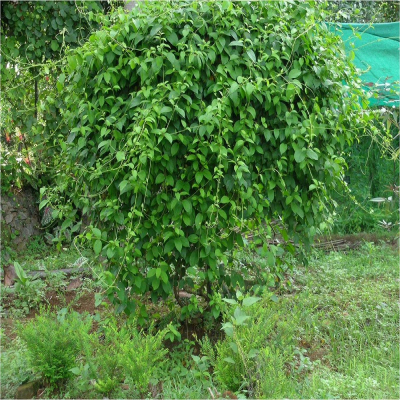Gymnema sylvestre (Retz.)R. Br.
Synonyms : Asclepias germinata Roxb.
Family : Apocynaceae
Group : Antidiabetic
Parts Used : Root , Leaf
Vernacular Names :-
| English | : | Gymnema ,Periploca of the woods |
| Malayalam | : | Chakkarakolli |
| Hindi | : | Merasimgi |
| Sanskrit | : | Madhunasini |
| Bengali | : | Merasingi |
| Kannada | : | Kadhasige |
| Tamil | : | Sakkarakolli |
Distribution and Habitat: Mainly grown in Western Ghats, Konkan, Tamil Nadu and some parts of Bihar. The plant is cultivated in plains of India but the drug is mainly imported from Afghanistan and Iran.
Botany: It is a much branched woody climber with pubescent young parts.
- Leaves: Simple, opposite, elliptic or ovate, more or less pubescent on both sides, base rounded or cordate.
- Flowers: Small, yellow and arranged in umbellate cymes.
- Fruits: Slender and follicles are upto 7.5 cm long.
Properties: Anti-inflammatory, antidiabetic. The fresh leaves when chewed have the remarkable property of paralyzing the sense of taste for sweet and bitter substance for some time.
Chemical constituents: Nonacosane and hentriacontane were isolated from the hexane extract of leaves. An alkaloid gynamine which is a trace constituent was isolated and identified. Antisweet constituent of the leaves has been found to be a mixture of triterpene saponins.
Uses:It is reported to cure cough, dyspnoea, ulcers, and pain in the eyes. The plant is useful in inflammations, dyspepsia, constipation, jaundice etc. Root has long been reputed as a remedy for snakebite. The drug is used to strengthen the function of heart, cure jaundice, piles, urinary calculi, and intermittent fevers. The drug enters into the composition of preparations like Ayaskrti, Varunadi kasaya, Varunadighrtam, Mahakalyanakaghrtam, etc.
Agrotechnology
Soil and climate: It can be grown in all types of climatic conditions. It can be grown in all types of soil preferably with good drainage system. During the month of February to March pits of 30 x 30 x 30 cm size are to be taken at the distance of 5 x 5 m filled with 10 kg farm yard manure and soil mixture.
Propagation: Propagated both by seeds and stem cuttings. Seedlings are to be raised in poly bags. Pits of size 50 cm3 are to be taken, filled with 10 kg dried cowdung or FYM and covered with topsoil. On these pits about 3-4 months old seedlings are to be transplanted from poly bags.
Manures and Fertilizers: Regular application of organic manures is essential for vigorous growth. The 20g urea and 40g single super phosphate can be given per plant frequently. An irrigation should be given just after each fertilizer application.
Irrigation: Crop should be irrigated regularly.
Plant protection: The plant is not affected by any serious insect pests or diseases.
Harvesting: Leaves can be collected from the first year onwards at an interval of one week. This can be continued for 10-12 years. Generally the leaves are collected in the month of December and January. Fresh or dried leaves can be marketed. The collected leaves are dried in shadow. The roots can be uprooted in summer season, which may be thoroughly washed, sun dried and stored.

